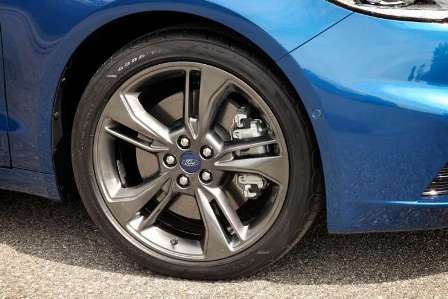Did you know that at 60km/h, the sole contact between the road and your car is a small patch on your tyres about the size of your palm? As the only part of your car that physically touches the ground, it’s imperative your tyres are properly maintained.
 Derek Kirkby, Training Director at Ford’s Driving Skills for Life (DSFL), a programme which aims to promote a safe and economical driving culture, says that tyres in good shape ensure a much safer journey, and even increase fuel efficiency.
Derek Kirkby, Training Director at Ford’s Driving Skills for Life (DSFL), a programme which aims to promote a safe and economical driving culture, says that tyres in good shape ensure a much safer journey, and even increase fuel efficiency.
“If you are just 0.3 BAR below the optimum tyre pressure, you increase the rolling resistance of your vehicle by up to 10 per cent,” he says. “And optimum tyre pressure can provide up to three per cent better fuel economy. It all adds up!”
Ford Motor Company and DSFL offers you four easy-to-remember tips on how to be more ‘street smart’, and show your tyres the love they deserve.
BRIT: Balance, Rotation, Inflation, Tread
- Balance
When your tyre and wheel assemblies aren’t balanced, you’ll get an uncomfortable ride, the steering wheel will vibrate, and you could do damage to your tyres and your suspension system. If you have a bumpy ride or you suspect that something may be wrong with your suspension, make sure to have your technician check if your wheels are balanced.
- Rotation
Tyre rotation usually involves moving tyres front to back, and not left to right, as most tyres are directional. To ensure your tyres wear evenly and last longer, have them rotated by a tyre expert at regular intervals as indicated by the vehicle or tyre manufacturer. Hard impact such as hitting a pothole can cause misalignment, which causes uneven tyre wear.
- Inflation
You should have your tyres, including your spare wheel, checked each time you stop at the filling station, or at least once a week, and preferably first thing in the morning when your tyres are cold. The optimum inflation pressure can be found on a sticker, usually located inside the driver’s door. Don’t exceed the optimum pressure, because over-inflating tyres reduces their performance in terms of both traction and lifespan. Tyres with low pressure wear more quickly, degrade your vehicle’s handling, lower your vehicle’s load-carrying ability, and increase fuel consumption.
- Tread
 Most tyres have a tread depth indicator, and once the tyre is worn to that point, it needs to be replaced. To a degree, the tread on your tyres increases their grip on the road, deflects water, and reduces slippage.
Most tyres have a tread depth indicator, and once the tyre is worn to that point, it needs to be replaced. To a degree, the tread on your tyres increases their grip on the road, deflects water, and reduces slippage.
How to Change a Tyre
Punctures happen to the best of us, at the worst of times. Follow these 10 steps and you’ll be back on the road in no time. Just remember, spare tyres aren’t designed for long distances or high speeds, so once you have replaced a punctured tyre with the spare, you need to visit a tyre technician to fix or replace the original tyre as soon as possible.
- Pull over as soon as it is safe to do so, preferably on level ground.
- Turn on the hazard lights, use the parking brake switch off the engine, and place the reflective triangle on the road 45m behind your vehicle.
- Take out the spare tyre, jack, and wrench. In most passenger vehicles, spare tyres are located under the floor of your boot, but on SUVs and 4x4s, spares can also be rear, side, roof, or underbody mounted.
- Remove the hubcap of the tyre that needs to be replaced, and loosen the lug nuts with the wrench, turning counter-clockwise. Use your body weight on the wrench if you need to.
- Place the jack beneath your vehicle next to the tyre, and use the jack to raise your vehicle until the tyre is about 15cm above the ground, then remove the loosened nuts by hand.
- Carefully pull the flat tyre towards you until it is off the bolts. Set it down on its side so it doesn’t roll away.
- Mount the spare tyre on the exposed bolts and replace the nuts, tightening them by hand.
- Use the jack to lower your vehicle until the tyre is resting on the ground, and tighten the nuts with the wrench as much as you can.
- Lower the vehicle completely to the ground, and remove the jack.
- Stow your flat tyre, jack, and wrench, and continue your journey.



